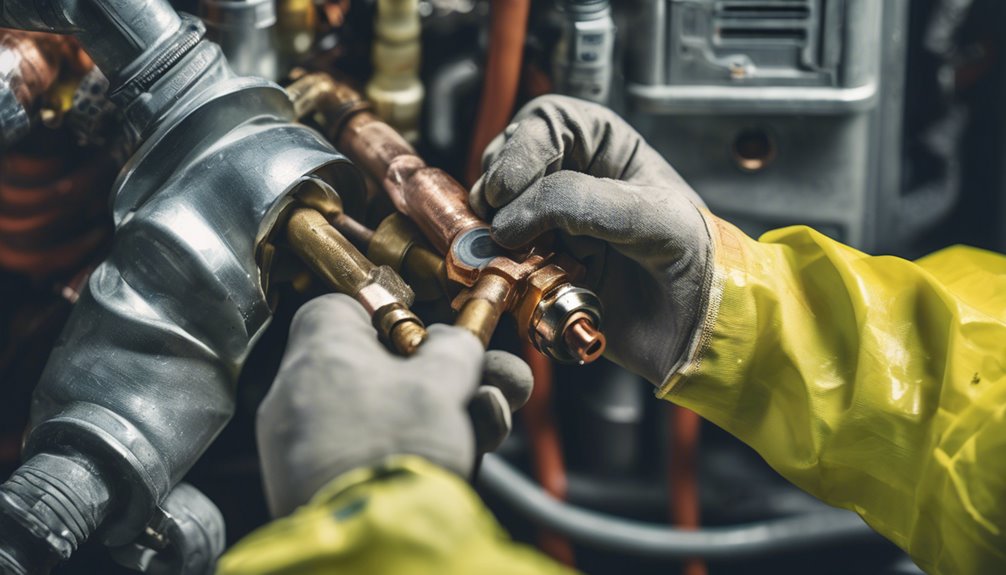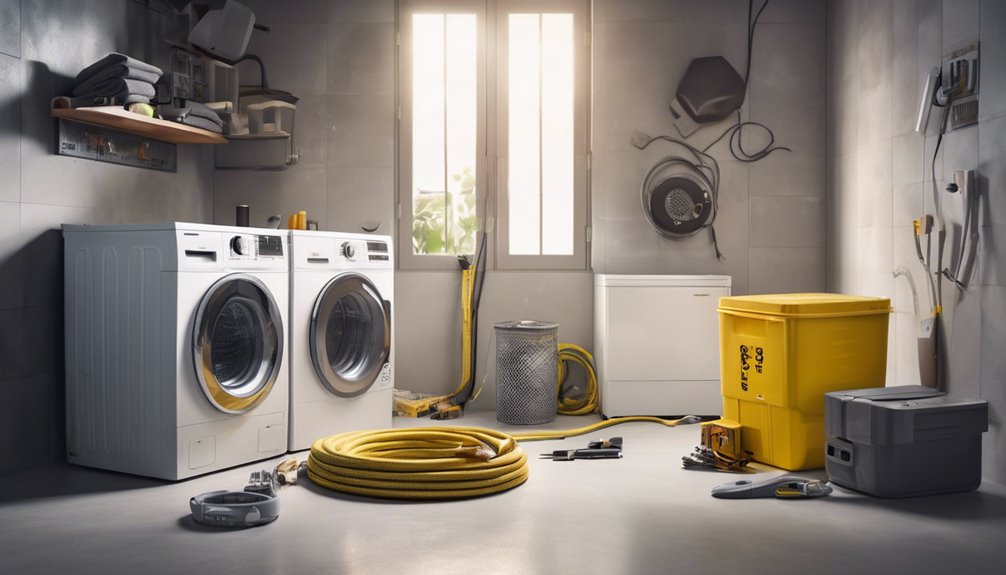To fix an AC gas leak permanently, you'll need to identify the source of the leak using methods like gas tracing and electronic detectors. Next, prepare your tools, evacuate the refrigerant, and isolate the leak. Then, use a repair kit to fix the issue or replace the leaky component. Finally, recharge the AC system and perform a leak-down test to ensure the fix is successful. By following these steps, you'll be well on your way to resolving the issue – and taking a closer look at the process will reveal even more details to ensure a lasting fix.
Key Takeaways
- Identify the source of the leak using a combination of detection methods, including gas tracing and electronic leak detectors.
- Evacuate the refrigerant from the system using a refrigerant recovery unit, following proper refrigerant handling procedures.
- Repair the leak using a repair kit, brazing or soldering the leaky joint, and replacing worn-out parts or faulty components.
- Recharge the AC system with the correct type and amount of refrigerant, ensuring the system is turned off and well-ventilated.
- Perform regular maintenance and inspections to prevent future leaks, identifying and addressing weaknesses in the system.
Identify the Source of the Leak
How do you know if your AC is leaking refrigerant? One way is to look for signs like increased energy bills, uneven cooling, or hissing sounds.
However, these symptoms don't pinpoint the leak's location. That's where leak detection methods come in.
You can use gas tracing techniques, such as adding a fluorescent dye to the refrigerant, to identify the source of the leak. Another method is to use electronic leak detectors that sense refrigerant in the air.
These tools help you narrow down the search area, making it easier to find the leak. By combining these methods, you'll be able to detect even small leaks and take the first step towards fixing your AC.
Prepare the Necessary Tools and Equipment
You'll need a range of tools and equipment to fix the AC gas leak effectively.
Proper tool selection is crucial to ensure a successful repair. A well-prepared equipment checklist will save you time and frustration in the long run.
Selecting the right tools is key to a successful AC gas leak repair, saving you time and frustration down the line.
- Refrigerant leak detector: A reliable leak detector to identify the source of the leak.
- Tubing cutter and bender: For cutting and bending new tubing to replace the damaged section.
- Refrigerant recovery unit: To safely recover refrigerant from the system.
- Gloves and safety glasses: To protect yourself from potential hazards during the repair process.
Evacuate the Refrigerant
The refrigerant recovery unit is now put to use as you evacuate the refrigerant from the system.
You'll need to follow proper refrigerant handling procedures to ensure a safe and efficient process. Wear appropriate safety gear, including gloves, safety glasses, and a face mask, to protect yourself from potential hazards.
Connect the recovery unit to the low-side port of your AC system, making sure all valves are securely tightened. Turn on the unit and let it draw out the refrigerant.
Monitor the process closely, as over- or under-evacuation can lead to further complications. Take your time, and don't rush through this critical step.
Locate and Isolate the Leak
With the refrigerant safely evacuated, it's time to focus on finding the source of the leak.
You'll need to employ effective leak detection methods to pinpoint the exact location of the leak. Pressure testing techniques can help you identify the affected component or joint.
- Inspect the AC unit's connections: Look for signs of moisture, oil, or refrigerant around fittings, valves, and hoses.
- Use a leak detector: These devices can detect even the slightest refrigerant leaks.
- Conduct a soap bubble test: Mix dish soap with water and apply it to suspected areas; bubbles will form if there's a leak.
- Perform a pressure hold test: Charge the system with nitrogen and monitor the pressure gauge for any drops, indicating a leak.
Fix the Leak With a Repair Kit
You've isolated the leak, now it's time to fix it with a repair kit.
First, you'll need to pinpoint the source of the leak, whether it's a worn O-ring, a cracked fitting, or something else.
Once you've identified the problem, you can seal the refrigerant leak with the appropriate materials from your kit.
Locate the Leak Source
Turn off the AC unit and unplug it from the power outlet to prevent further damage or safety risks.
You'll need to locate the source of the leak to fix it permanently.
- Inspect the connections: Check the connections between the compressor, condenser coils, and evaporator coils for any signs of wear or damage.
- Look for oily residue: Gas leaks often leave behind an oily residue, so inspect the surrounding area for any signs of this.
- Use gas detection tools: Specialized tools can help detect the presence of refrigerant gas, making it easier to pinpoint the leak.
- Check the drain pain: If the leak is coming from the drain pan, you may notice water accumulation or ice buildup.
Seal the Refrigerant Leak
Now that you've identified the source of the leak, it's time to seal it using a repair kit. This kit usually includes a sealant, a leak detector, and other necessary tools. Before applying the sealant, make sure the area is clean and dry.
| Leak Detection Methods | Refrigerant Properties |
|---|---|
| Soap Bubble Test | Low boiling point |
| Electronic Leak Detector | High pressure |
| Ultrasonic Leak Detector | Low viscosity |
| Infrared Leak Detector | High thermal conductivity |
| Halogen Leak Detector | Non-corrosive |
Follow the manufacturer's instructions to apply the sealant to the affected area. Ensure the sealant is compatible with the refrigerant used in your AC unit. Once applied, test the area again using a leak detection method to ensure the leak is sealed permanently.
Braze or Solder the Leaky Joint
To repair the AC gas leak, you'll need to braze or solder the leaky joint, which requires some skill and attention to detail.
Repairing an AC gas leak requires brazing or soldering the leaky joint, demanding skill and attention to detail.
This process involves joining two metal pipes together using heat and filler material.
Before you start, make sure you've cleaned the joint thoroughly to remove any dirt or debris that may interfere with the process.
- Joint Cleaning: Clean the joint with a wire brush to remove dirt and oils.
- Use the right Welding Techniques to ensure a strong bond.
- Apply heat evenly to avoid warping the metal.
- Inspect the joint carefully after brazing or soldering to ensure it's leak-free.
Replace the Leaky Component
If your AC gas leak is coming from a faulty valve, compressor, or other component, replacing it's often the most effective solution.
You'll need to identify the specific component that's leaking and purchase a replacement. Make sure to turn off the power to the AC unit before starting the replacement process.
Remove the faulty component, taking note of any electrical or refrigerant lines that need to be disconnected.
Install the new component, reconnecting any lines as needed. If you're replacing a gas valve, ensure it's compatible with your AC unit's refrigerant type.
Properly seal all connections to prevent future leaks. With the new component in place, you can rest assured that the leak is fixed permanently.
Recharge the Air Conditioner
You've replaced the leaky component, now it's time to recharge your air conditioner.
First, you'll need to check the refrigerant levels to determine how much refrigerant is needed.
If the levels are low, you'll need to add new refrigerant to ensure your AC is running efficiently and effectively.
Check Refrigerant Levels
Your air conditioner's refrigerant levels are crucial to its proper functioning, and low levels can be a sign of a gas leak.
If you suspect a leak, it's essential to check the refrigerant levels to determine the severity of the issue.
You can perform refrigerant checks by looking out for low pressure signs, such as:
- Reduced cooling performance: If your AC isn't cooling as it should, it might be due to low refrigerant levels.
- Increased energy bills: Low refrigerant levels can cause your AC to work harder, leading to higher energy bills.
- Ice buildup: If you notice ice forming on the coils or pipes, it could be a sign of low refrigerant levels.
- Hissing or bubbling sounds: Unusual noises from your AC can indicate a refrigerant leak.
Add New Refrigerant
Now that you've identified the signs of a refrigerant leak, it's time to recharge your air conditioner with new refrigerant.
You'll need to determine the correct refrigerant type for your AC unit, as there are different types, such as R-22, R-410A, and R-32. Make sure to purchase the correct type to avoid further damage.
When recharging, ensure the system is turned off and the area is well-ventilated. Connect the recharge kit to the low-side port and slowly add the new refrigerant. Monitor the pressure gauge to avoid overcharging.
To prevent future leaks, inspect the system for any signs of wear or damage and replace worn-out parts. By following these steps, you'll be able to add new refrigerant and fix the AC gas leak permanently.
Perform a Leak-Down Test
A leak-down test is a valuable diagnostic tool for identifying where refrigerant is escaping from your air conditioning system.
This test helps you pinpoint the exact location of the leak, which is crucial for a permanent fix. You'll need to connect a leak-down tester to the low-side port of your AC system. Then, pressurize the system with nitrogen or another inert gas to simulate system pressures.
Here's what you should expect from a leak-down test:
- Accurate leak detection: Identify the source of the refrigerant leak.
- Quick diagnosis: Get results fast, so you can start repairs sooner.
- Cost-effective: Avoid replacing unnecessary parts or wasting time on trial-and-error repairs.
- Long-term fix: Ensure your repair lasts by finding the root cause of the leak.
Inspect and Test the AC System
The AC system's components, including hoses, fittings, and seals, are prone to wear and tear, making them common culprits behind refrigerant leaks.
When you inspect and test the AC system, you'll want to perform a thorough system analysis to identify any potential weaknesses.
Start by visually inspecting the system for signs of damage, corrosion, or wear.
Then, conduct pressure checks to detect any leaks or drops in pressure.
You'll need to use specialized equipment, such as a pressure gauge, to accurately measure the system's pressure.
Be sure to follow the manufacturer's guidelines for pressure checks and take notes on your findings.
This step will help you pinpoint the source of the leak and inform your repair strategy.
Frequently Asked Questions
Can I Fix an AC Gas Leak Myself Without Professional Help?
You're wondering if you can fix an AC gas leak yourself without professional help, but be aware that DIY risks and amateur mistakes can lead to further damage, safety hazards, and even complete system failure, so it's often best to seek expert assistance.
How Long Does It Take to Fix an AC Gas Leak?
You'll spend around 30 minutes to several hours detecting the leak, depending on the system's complexity. After that, the repair time will vary greatly, taking anywhere from 30 minutes to several days, depending on the repair complexity.
Is It Safe to Use an AC With a Small Gas Leak?
You're wondering if it's safe to use an AC with a small gas leak. When assessing the risk, consider your leak tolerance – even a small leak can cause health issues or environmental harm, so it's best to err on the side of caution.
Can a Gas Leak Cause an AC to Freeze Up?
You're wondering if a gas leak can cause your AC to freeze up, and the answer is yes, it can. When refrigerant migrates to the freezer coils, it can cause them to ice over, leading to a frozen AC unit.
Will a Gas Leak Affect My Ac's Energy Efficiency?
You'll notice a significant drop in your AC's cooling performance due to the gas leak, which increases energy consumption, making your unit work harder and driving up your bills – it's a costly combo!
Conclusion
You've successfully fixed the AC gas leak! Now, turn on the AC and check its performance. Monitor the system for any signs of leakage or malfunction. Remember to perform regular maintenance to prevent future leaks. Keep in mind that if you're not comfortable with DIY repairs, it's always best to consult a professional. With your newly acquired skills, you'll be able to identify and fix AC gas leaks like a pro!


